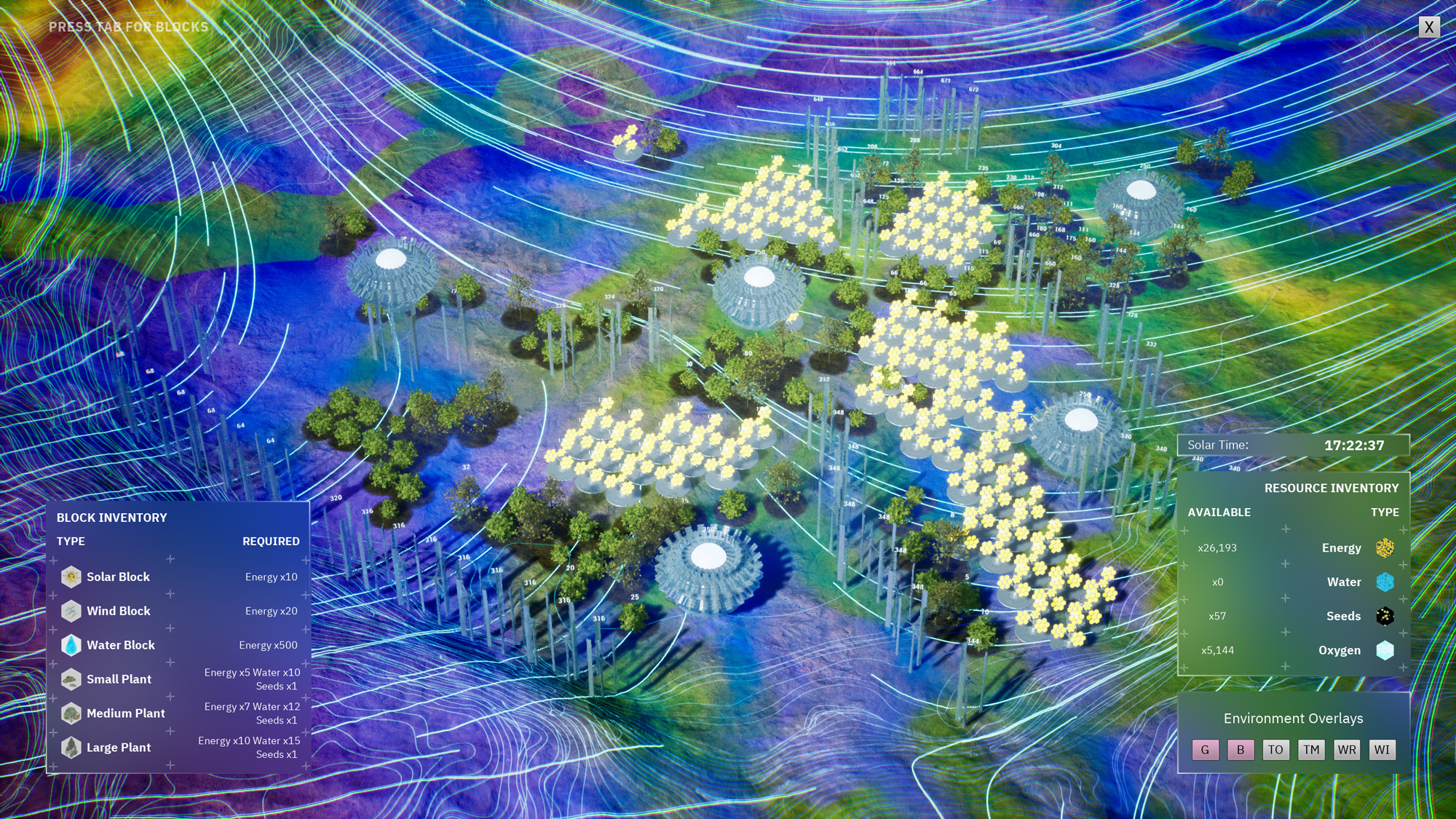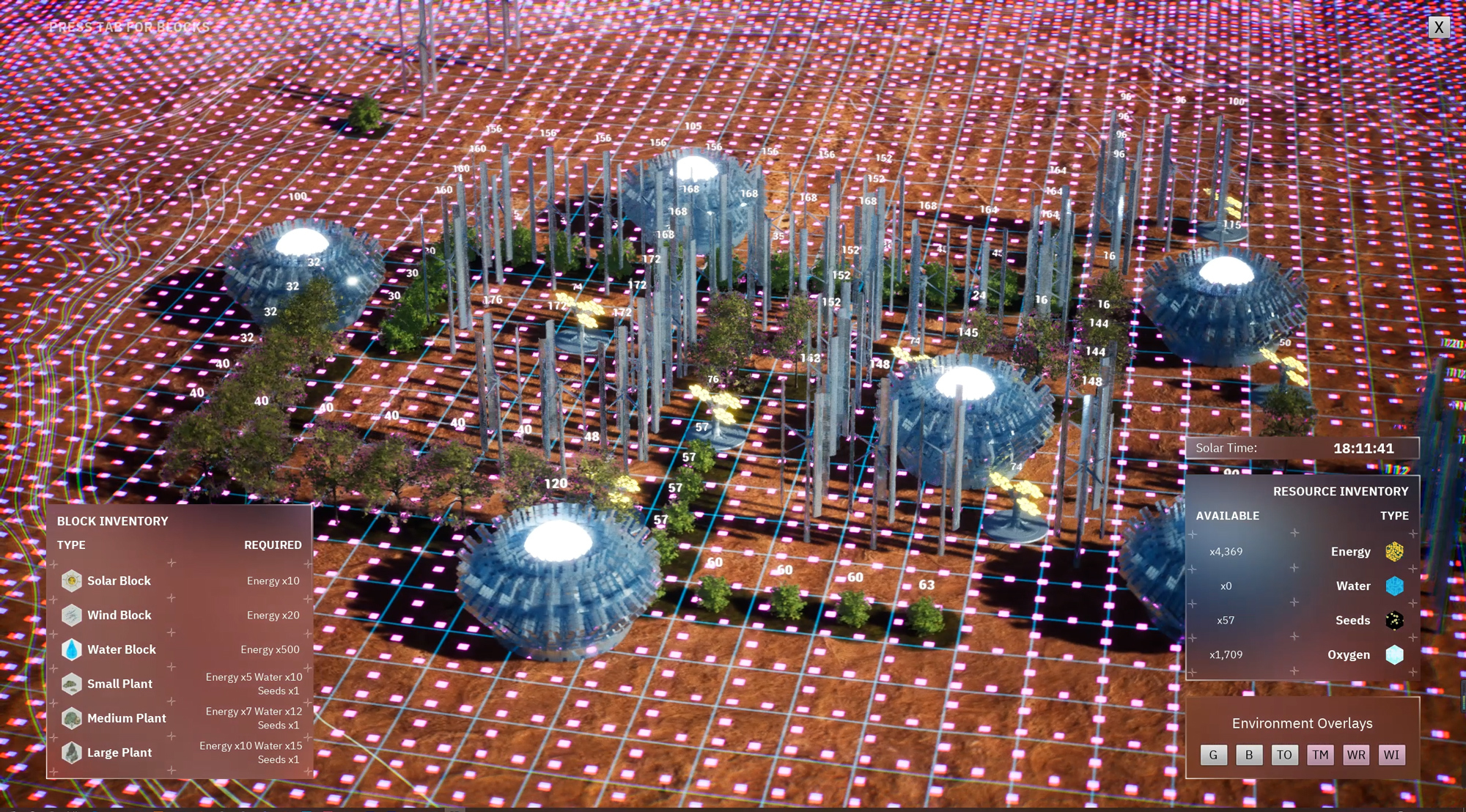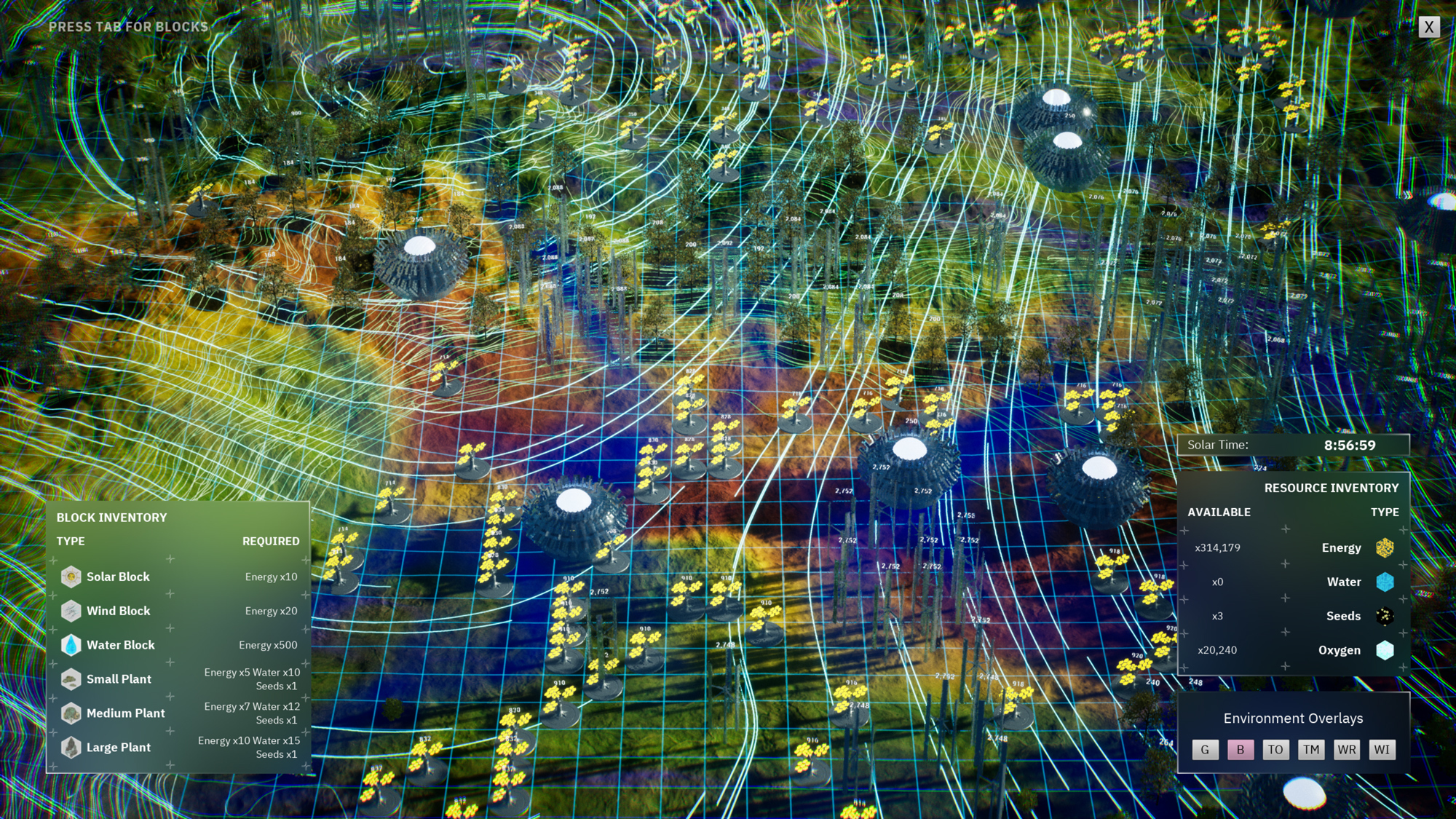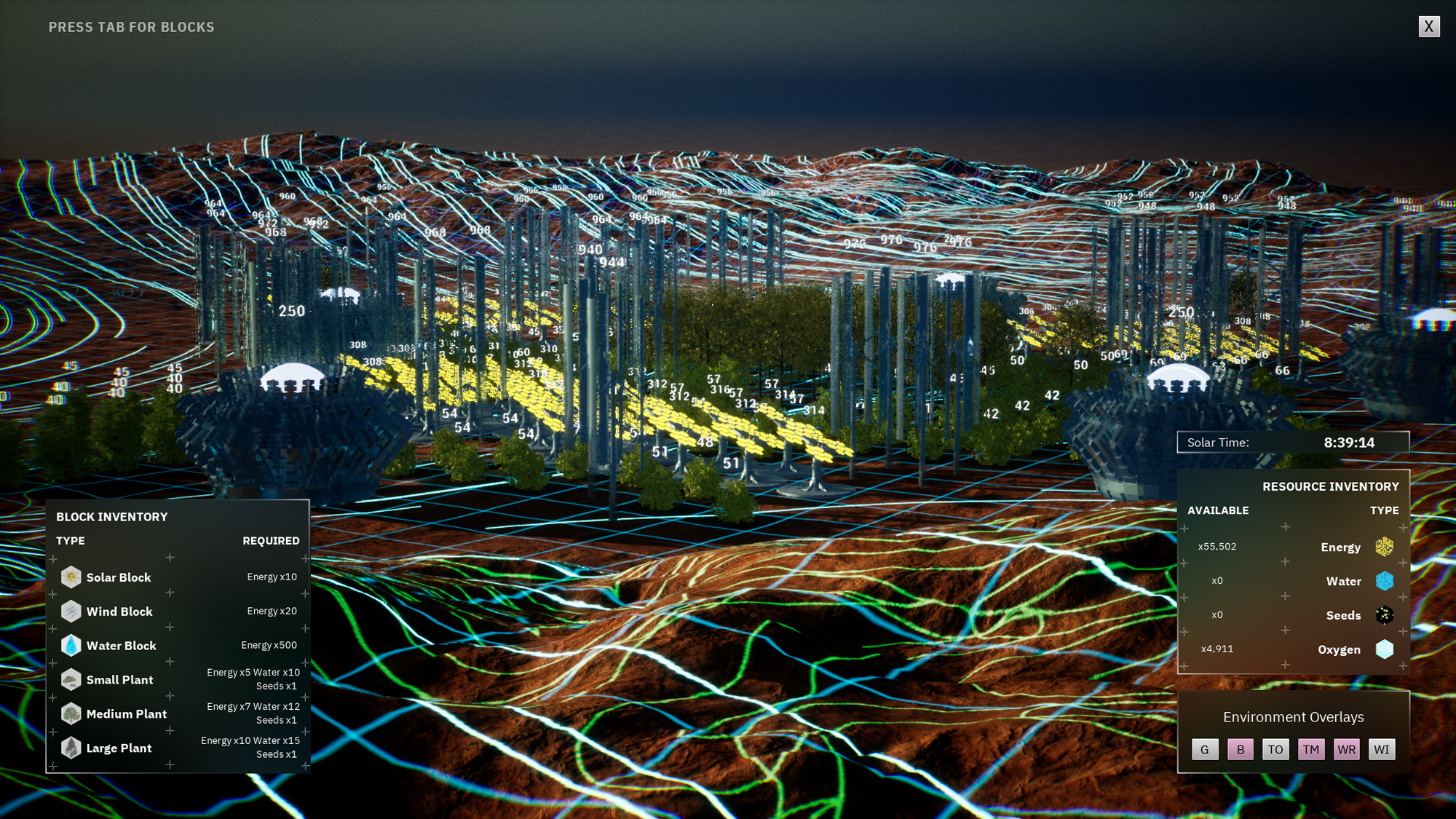Damjan Jovanovic on Views of Planet City, Getty PST, and Worldmaking with Unreal Engine
Views of Planet City, now underway, encompasses a range of explorations that engage students and faculty with globally influential scholars, artists, scientists, and technologists, beginning with Young’s framing conceptualization of Planet City through an architectural grand tour of large-scale infrastructures showing the first intimations of a planet city already in the making: massive solar farms, super-tech lettuce fields, the world’s largest freshwater dam—these are the modern wonders of the built environment, hiding in plain sight, on the periphery of our cities, yet inaccessible, but with a potential that is fundamental to our future.

Planet City Simulator is one of the projects that comprise SCI-Arc’s Views of Planet City. It is a simulation game that uses Unreal Engine and machine learning to generate a continuously evolving, interactive 3D model of a single city designed to house 7.5 billion people, currently being developed by M. Casey Rehm and Damjan Jovanovic. Says Jovanovic of his and Rehm’s contribution to the project, “In order to imagine and model the scale and complexity of E.O. Wilson's City, we go beyond maps and diagrams and into the realm of video game simulation. The Simulator is both an interactive model of complex urban conditions, and a new narrative structure for architectural worldmaking.”
We spoke to Jovanovic to learn more about the ideas involved in his contribution to the Getty’s Pacific Standard Time exhibition.
Can you speak about how the original impetus for this project—EO Wilson’s Half Earth proposition—led to the development of your project for Views of Planet City?
The story of Half Earth, and especially the very big city that is implied in it, is an important and very interesting thought experiment. It is almost a proto design, a prompt, an idea for a massive, planetary agglomeration of urban matter which could liberate the rest of the planet to heal and rewild. I started thinking about the design side of it: how could we actually model something like that? How do we capture all that complexity and nuance, how do we figure out stakes and variables and come up with consequences and conclusions? I realized that it would be necessary to employ systems thinking and go beyond the architect’s standard toolkit of drawings, diagrams, or videos; this would also mean that the project will present a new kind of a model. The question of the model became central at this point, reframed in my case as a computer game: a dynamic, playable simulated complex system, not just a cool looking 3D model of the city. I started thinking about the city as an interconnected and nested dynamic system with components interacting on multiple scales, which is something video games can simulate really well. To model such a system requires going into multiple other disciplines and learning their operational strategies while keeping an eye on what makes the work important architecturally.

Can you describe the simulation game that you’re making with M. Casey Rehm for the Getty PST exhibition?
The game is a simulation of an enormous city for 10 billion people, and it is made with Unreal Engine. We model various aspects of the planetary city, and the player will be able to operate on multiple spatial sectors and urban scales. The player can explore different ways to influence the development and growth of the city and test many scenarios, but the game will also run on its own, so that the city can exist without direct player input. The game belongs to a genre of ‘serious’ simulation games, and we researched the work of the game designer Will Wright (in particular games like SimEarth, SimCity, and The Sims), as well as some other important games like Sid Meier’s Civilization and Paradox Studio’s Stellaris. These games are conceptually very ambitious and extremely complex as they model the evolution of whole societies and civilizations, and they also operate on very long timescales. These types of games are open-ended and not bound to one goal and there is rarely a clear win state. It was very interesting to learn what kinds of mathematical models, but also assumptions and biases, are behind these games. For example, SimCity is well known (and some would say notorious) for its rootedness in Jay Forrester’s Urban Dynamics approach, which means that its mathematical model delivers very specific urban conditions and ultimately, a very specific vision of what a city is and could be. One of the main questions in our project became how we can update this approach on two fronts: by rethinking the mathematical model and by rethinking urban assumptions of the conceptual model. Our game utilizes the core design principles that have to do with system dynamics, evolution, environmental conditions, and change. A major point is the player’s input and decision-making process, which influences the outcome of the game. The game will also be able to present conditions and consequences of this urban thought experiment, as something is always at stake for the player. The core of the simulation-as-a-model idea is that there are testable consequences of a design.
How has your understanding of the power of imaginary worlds grown throughout the process?
We live in a period of unprecedented multiplication and even inflation of constructed, internally coherent worlds, which pop up everywhere, from politics to video games. One ripple effect of this phenomenon is that we are now asking fundamental questions, such as what consensus reality is and how to engage it. Another effect is that there is a need for a special kind of expertise that can deal with designing and organizing these worlds and that is where architects possibly have a unique advantage. These notions are central to my research interest in the intersection of games and architectural design. I do believe that we as architects have a unique perspective and should have a say in how these worlds are constructed and inhabited. But there is a question of how we engage this: do we simply adopt and repeat the tropes and cliches of the entertainment industry and remain at the stage of mythologizing or can we go deeper and learn from scientific ways of imaging and sensing to construct new, legitimate, and serious ways of seeing and modeling? While working on The Simulator project, I started believing more and more in the latter, began rethinking the working concept of a design fiction—which was previously an important part of my conceptual position as a designer—and replacing it with the new core idea of the simulation. The research led me to discover the work of philosophers Federico Campagna, who writes about Worlds, as well as Stefano Gualeni, whose book Virtual Worlds as Philosophical Tools was a big revelation. All of this prompted me to start working on a new research website, which you can access at worldmaking.xyz.

You’ll also be collaborating with four other fellow SCI-Arc faculty (Angelica Lorenzi, Liam Young, John Cooper, and Jennifer Chen). Can you tell us anything about how those collaborations will be taking shape?
All the projects share the same overarching theme, but approach it from very different angles, so there is a lot of potential overlap and possibility of learning from each other. We have regular conversations where aspects of projects are discussed, and for me that is a time to learn about things which are in my project only tangentially, such as ideas of rewilding, alternative forms of politics and governance, novel ways to see the planet from outer space, etc. I think eventually all the projects will amalgamate into an incredible exhibition which will have the capacity to ask genuinely important questions and quite possibly give a new direction to the future of planetary design.

How do you see the shifting landscape of your work within the context of the ever-changing, ever-worsening global climate crisis?
One of the reasons why it is difficult to really comprehend a kind of complex system such as the climate crisis is because it is difficult to model it, which also means to visually represent or image it in a legible way which humans can understand. This crisis of representation is a well-known problem in the literature on the Anthropocene, for example in the book Against the Anthropocene, by T.J. Demos. We do not yet have the tools and formats of visualizing that can fully and legibly describe such a complex thing, and this is, in a way, also a failure of architectural imagination. The standard architectural toolkit is limited and also very dated—it is designed to describe and model objects, not hyperobjects. I am very interested in inventing new modalities of description and modeling of complex systems through the interactive software format, and this is one of the ideas behind the Simulator project. The game we are designing is a means to model and host hugely complex urban systems which unravel over time, while being able to legibly present an enormous amount of information visually and through the narrative. One thing that architects could do is work on new ways of imaging the World and making sense of reality through models, and that is one area where we could contribute to the climate change problem without falling into naïve solutionism.
Is there anything else you can share about Views of Planet City, the Getty PST exhibition, or upcoming projects?
During the 2021 summer semester at SCI-Arc, I instructed a seminar called Games and Worldmaking, which served as an entry point into the Simulator project. In the seminar, we worked with Unreal Engine to create a small game called Planet Garden, which was a way to test ideas for the Simulator. Planet Garden is a multi-scalar, interactive, playable model of a self-sustaining, wind and solar-powered robotic garden, set in a desert landscape. The simulation was envisioned as a kind of reverse city builder, where a goal of the game is to terraform a desert landscape by deploying different kinds of energy-producing technologies, until the right conditions are met for planting and the production of oxygen. The basic game loop is based on the interaction between the player and four main resources: energy, water, carbon, and oxygen. The aim of the seminar was to learn how to model dynamic systems and explore how to utilize game workflows as ways to address urban issues. Many of the ideas from Planet Garden will end up being applied to the Simulator, in different ways.
Credits:
Instructor, game design:
Damjan Jovanovic
Models:
Nikhil Bang
Xiaolei Liu
Hakcheol Seo
Sanghyun Suh
Landscape Design:
Ilaria Lu
Yaqing Mao
Caleb Roberts
Runhuan Wang
Vegetation:
Mariam Aramyan
Wen Chen
Shuo Feng
Yehong Mi
Interface Design:
Yuhong Gong
Robert Leising
Pan Tan
Game Manual:
Eva Besmerti
Carlo Sturken